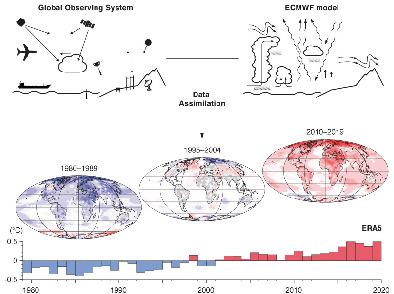当前位置:
X-MOL 学术
›
Q. J. R. Meteorol. Soc.
›
论文详情
Our official English website, www.x-mol.net, welcomes your feedback! (Note: you will need to create a separate account there.)
The ERA5 global reanalysis
Quarterly Journal of the Royal Meteorological Society ( IF 8.9 ) Pub Date : 2020-06-15 , DOI: 10.1002/qj.3803 Hans Hersbach 1 , Bill Bell 1 , Paul Berrisford 1 , Shoji Hirahara 2 , András Horányi 1 , Joaquín Muñoz‐Sabater 1 , Julien Nicolas 1 , Carole Peubey 1 , Raluca Radu 1 , Dinand Schepers 1 , Adrian Simmons 1 , Cornel Soci 1 , Saleh Abdalla 1 , Xavier Abellan 1 , Gianpaolo Balsamo 1 , Peter Bechtold 1 , Gionata Biavati 1 , Jean Bidlot 1 , Massimo Bonavita 1 , Giovanna Chiara 1 , Per Dahlgren 3 , Dick Dee 1 , Michail Diamantakis 1 , Rossana Dragani 1 , Johannes Flemming 1 , Richard Forbes 1 , Manuel Fuentes 1 , Alan Geer 1 , Leo Haimberger 4 , Sean Healy 1 , Robin J. Hogan 1 , Elías Hólm 1 , Marta Janisková 1 , Sarah Keeley 1 , Patrick Laloyaux 1 , Philippe Lopez 1 , Cristina Lupu 1 , Gabor Radnoti 1 , Patricia Rosnay 1 , Iryna Rozum 1 , Freja Vamborg 1 , Sebastien Villaume 1 , Jean‐Noël Thépaut 1
Quarterly Journal of the Royal Meteorological Society ( IF 8.9 ) Pub Date : 2020-06-15 , DOI: 10.1002/qj.3803 Hans Hersbach 1 , Bill Bell 1 , Paul Berrisford 1 , Shoji Hirahara 2 , András Horányi 1 , Joaquín Muñoz‐Sabater 1 , Julien Nicolas 1 , Carole Peubey 1 , Raluca Radu 1 , Dinand Schepers 1 , Adrian Simmons 1 , Cornel Soci 1 , Saleh Abdalla 1 , Xavier Abellan 1 , Gianpaolo Balsamo 1 , Peter Bechtold 1 , Gionata Biavati 1 , Jean Bidlot 1 , Massimo Bonavita 1 , Giovanna Chiara 1 , Per Dahlgren 3 , Dick Dee 1 , Michail Diamantakis 1 , Rossana Dragani 1 , Johannes Flemming 1 , Richard Forbes 1 , Manuel Fuentes 1 , Alan Geer 1 , Leo Haimberger 4 , Sean Healy 1 , Robin J. Hogan 1 , Elías Hólm 1 , Marta Janisková 1 , Sarah Keeley 1 , Patrick Laloyaux 1 , Philippe Lopez 1 , Cristina Lupu 1 , Gabor Radnoti 1 , Patricia Rosnay 1 , Iryna Rozum 1 , Freja Vamborg 1 , Sebastien Villaume 1 , Jean‐Noël Thépaut 1
Affiliation

|
Within the Copernicus Climate Change Service (C3S), ECMWF is producing the ERA5 reanalysis which, once completed, will embody a detailed record of the global atmosphere, land surface and ocean waves from 1950 onwards. This new reanalysis replaces the ERA‐Interim reanalysis (spanning 1979 onwards) which was started in 2006. ERA5 is based on the Integrated Forecasting System (IFS) Cy41r2 which was operational in 2016. ERA5 thus benefits from a decade of developments in model physics, core dynamics and data assimilation. In addition to a significantly enhanced horizontal resolution of 31 km, compared to 80 km for ERA‐Interim, ERA5 has hourly output throughout, and an uncertainty estimate from an ensemble (3‐hourly at half the horizontal resolution). This paper describes the general set‐up of ERA5, as well as a basic evaluation of characteristics and performance, with a focus on the dataset from 1979 onwards which is currently publicly available. Re‐forecasts from ERA5 analyses show a gain of up to one day in skill with respect to ERA‐Interim. Comparison with radiosonde and PILOT data prior to assimilation shows an improved fit for temperature, wind and humidity in the troposphere, but not the stratosphere. A comparison with independent buoy data shows a much improved fit for ocean wave height. The uncertainty estimate reflects the evolution of the observing systems used in ERA5. The enhanced temporal and spatial resolution allows for a detailed evolution of weather systems. For precipitation, global‐mean correlation with monthly‐mean GPCP data is increased from 67% to 77%. In general, low‐frequency variability is found to be well represented and from 10 hPa downwards general patterns of anomalies in temperature match those from the ERA‐Interim, MERRA‐2 and JRA‐55 reanalyses.
中文翻译:

ERA5全球重新分析
ECMWF正在哥白尼气候变化服务中心(C3S)中进行ERA5再分析,该分析一旦完成,将详细记录1950年以后的全球大气,陆地和海浪。这项新的重新分析方法取代了2006年开始的ERA-临时重新分析方法(始于1979年)。ERA5基于2016年投入运行的综合预测系统(IFS)Cy41r2。ERA5得益于模型物理学十多年的发展,核心动态和数据同化。除了显着提高了31 km的水平分辨率(相比ERA-Interim的水平分辨率为80 km)之外,ERA5始终每小时输出一次,并且总体上具有不确定性估计值(每小时3次,水平分辨率为一半)。本文介绍了ERA5的一般设置,以及对特性和性能的基本评估,重点是从1979年开始公开的数据集。通过ERA5分析进行的重新预测显示,相对于ERA-Interim,该技能最多可提高一天。与同化之前的探空仪和PILOT数据进行比较表明,对流层(而不是平流层)对温度,风和湿度的拟合度有所提高。与独立浮标数据的比较表明,海浪高度的拟合度大大提高。不确定性估计反映了ERA5中使用的观测系统的演变。增强的时间和空间分辨率可实现天气系统的详细演变。对于降水,与月均GPCP数据的全球平均相关性从67%增加到77%。一般来说,
更新日期:2020-06-15
中文翻译:

ERA5全球重新分析
ECMWF正在哥白尼气候变化服务中心(C3S)中进行ERA5再分析,该分析一旦完成,将详细记录1950年以后的全球大气,陆地和海浪。这项新的重新分析方法取代了2006年开始的ERA-临时重新分析方法(始于1979年)。ERA5基于2016年投入运行的综合预测系统(IFS)Cy41r2。ERA5得益于模型物理学十多年的发展,核心动态和数据同化。除了显着提高了31 km的水平分辨率(相比ERA-Interim的水平分辨率为80 km)之外,ERA5始终每小时输出一次,并且总体上具有不确定性估计值(每小时3次,水平分辨率为一半)。本文介绍了ERA5的一般设置,以及对特性和性能的基本评估,重点是从1979年开始公开的数据集。通过ERA5分析进行的重新预测显示,相对于ERA-Interim,该技能最多可提高一天。与同化之前的探空仪和PILOT数据进行比较表明,对流层(而不是平流层)对温度,风和湿度的拟合度有所提高。与独立浮标数据的比较表明,海浪高度的拟合度大大提高。不确定性估计反映了ERA5中使用的观测系统的演变。增强的时间和空间分辨率可实现天气系统的详细演变。对于降水,与月均GPCP数据的全球平均相关性从67%增加到77%。一般来说,



























 京公网安备 11010802027423号
京公网安备 11010802027423号